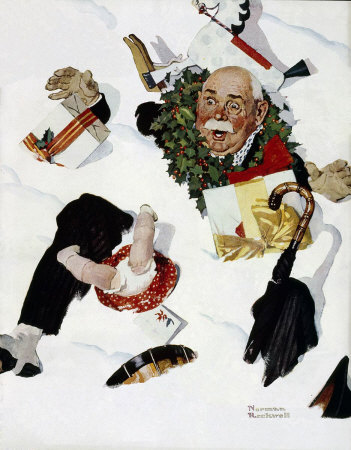
As I get older I seem to look forward to winter less. I’m not as hot-blooded, and where I once threw snowballs without gloves and saw my hands glow a ruddy red, my hands now turn blue at the slightest excuse. Not that I still don’t hope for a white Christmas; I just hope we get around an inch at daybreak, and it melts away by Christmas afternoon.
It was said, back when I was young, that the Indians called an old man “one who has seen many winters.” I’m not sure how true that statement is, in terms of history, but it says something about how winters tax a man. Like the taxes of a greedy government, winters sap you, and take so much out of you that you get tired of paying. However, for the poor, there is no escape to Florida, and therefore the mind has to adopt some sort of strategy, in order to endure the coming insult to our physical forms. After all, if you believe in evolution, we are jungle monkeys, at home in a Garden of Eden, and not upon tundra.
Even if you don’t believe in evolution, it has been a long, long time since we dwelt in Eden. Even if you don’t believe in evolution, perhaps we have been bred like dogs into certain breeds. Even if you don’t believe in evolution, it seems obvious that people to the north have whiter skin than people to the south, as sunshine is necessary, to produce Vitamin D, but you can get too much of a good thing, in which case sunshine causes skin cancer. God does amazing things to protect His children, and white skin allows people to get enough vitamin D where sunshine is low and weak, while dark skin prevents skin cancer when the sun is high, hot, and burns.
I have started to wonder if there are some other traits which have been imparted to northern people, that help them deal with winter. Because I run a Childcare, it seemed a good place to study the way the young react to the change in seasons, to see if they have any behaviors that seem northern in nature.
My study seemed especially insightful because modern children live lives so insulated from the outdoors, as do their parents. Parents chose our Childcare because they believe the outdoors is good, in theory; in actual fact they work indoors and only a few get out for hikes on the weekends. Therefore the children, who unknowingly were about to become subjects of my highly scientific study, were pure, and not corrupted by earlier experience of the outdoors. I could see responses that were fresh, and showed primal instincts.
One thing that became clear was that “shelter” became abruptly more important, as days swiftly grew shorter.
Not that children don’t build structures in the summer, but these are largely “forts”, and are built for warfare. “Warfare?” you ask? Yes, sad to say, but children do have a less than harmonious side, and build all sorts of forts that display sexism (“girls only” and “boys only”) and ageism (“big-kids-only” and “little-kids-only”) and even status-ism (“cool-crowd-only” and “uncool-crowd-only”), and then they steal sticks from each others forts and then rage about the robberies. You’d be amazed by how much time I have to spend overseeing the ownership of sticks. We have no toy guns at our Childcare, but over and over I hear either, “He keeps aiming his stick at me!” or “He stole my stick!” Sometimes I can muster the wisdom of Solomon, “I’ll tell you what I’ll do; I’ll break the stick in two and give you each half,” but other times the only escape is to get away from the forts altogether, by going on a hike.
It was on hikes I first noticed the sudden interest in shelter. During summer rains I have a hard time getting children to bother with raincoats, and often wind up carrying raincoats they shed, as they delight in becoming drenched. However, as the sun sank lower in the southern sky at noon, the rain-clouds darkened, and suddenly the children wanted not only raincoats, but umbrellas, though the wind was from the south and rain wasn’t all that colder. As I happened to have seven umbrellas, I handed them out to the children, taking notes, for my highly scientific study, of this sudden interest in shelter.

The rain then stopped, and you might think I’d then wind up carrying seven umbrellas. In actual fact I only wound up carrying five, because some sort of greed kicked in, and two umbrellas became some sort of status symbol. I had to break up fights, and teach “sharing”, and have them “take turns”. However it was when we entered the forest and were beneath the shelter of trees that I got a surprise. They all demanded their umbrellas back. It wasn’t because the rain had started again. It was because they wanted to build a shelter. I took a picture, for my highly scientific study.
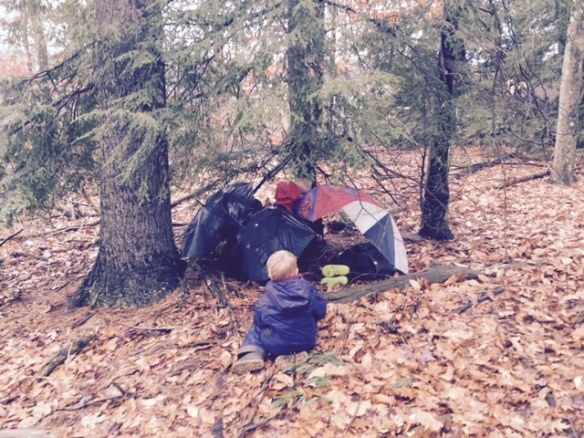
When we returned from our hike and I collected the umbrellas, (slightly the worse for wear), I became aware of a second attribute seen in northern children, which seems unlikely and only was revealed due to a mistake I made when I first opened the Childcare ten years ago. Back then I thought kids might be interested in old fashioned stuff, which is basically Neanderthal by modern standards: I showed them how to split wood with an ax and lay a campfire.
Big mistake. There is nothing more exhausting than having to oversee children swinging axes, and children by a campfire is nearly as bad. However the activity was incredibly popular, and the older children infected the younger with the desire to wave axes and feed fires. Any hope the interest would die away as the older children moved on from Childcare to more formal schooling, and I ceased to actively promote the activity, was dashed by the children who remembered the year before, and pleaded, “Please, please, Puh-leese can we chop wood and have a fire?”
To some degree it is gratifying to watch a boy grow from barely being able to lift an ax to becoming proficient at reducing a fat log to kindling. At times I think the Neanderthal were on to something. Rather than Ritalin they gave boys axes, and rather than drugged faces they saw faces that shone with pride:
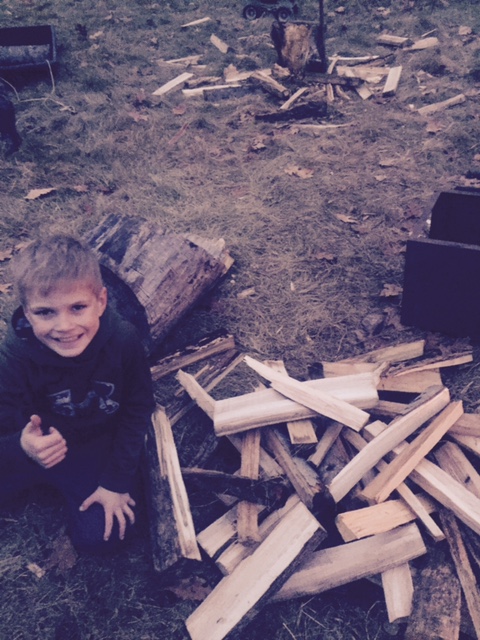
But there is no getting around the fact I have to work pretty hard to teach a boy to split wood with a Neanderthal implement. Some might say it is easier to just send them off to fight Arabs, so we can be lazy and just spin the dial of a thermostat, heating our homes with Arab oil. Never mind that the back yards of some homes are forests full of dead trees and fallen wood, (which is great for the local populations of woodpeckers, but represents an increasing forest fire danger during droughts).
Never mind that. That is a loaded subject for some future post. Instead let us face the fire-danger wood-stoves present us with. The poorer people in this area are still Neanderthal, and still burn wood, and fires do escape stoves, and houses do burn down, which means the fire department needs to educate children about what to do in a fire.
One thing that upsets children is that a fully dressed fireman looks, and even sounds, like the evil Darth Vader of Star Wars movies. Firemen entering homes to save children have seen them take one look at their rescuer and run the other way. Therefore they come to my Childcare and show that they are smiling, nice people, before they dress in scary-looking gear. Even though the children have seen the nice people put the gear on, they still tend to be scared once it is on.
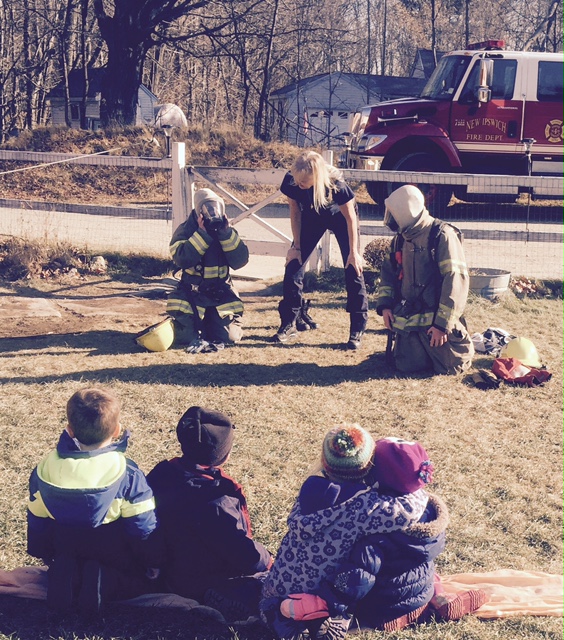 To be accurate, as a reporter, I should add it is somewhat amazing I was even able to take the above picture, because the Darth Vader appearance of the firemen completely freaked-out a two-year-old, who was wailing in my arms. He wouldn’t let go, even when they took off the costumes and let the other children experience the sublime joy of sitting in a firetruck.
To be accurate, as a reporter, I should add it is somewhat amazing I was even able to take the above picture, because the Darth Vader appearance of the firemen completely freaked-out a two-year-old, who was wailing in my arms. He wouldn’t let go, even when they took off the costumes and let the other children experience the sublime joy of sitting in a firetruck.
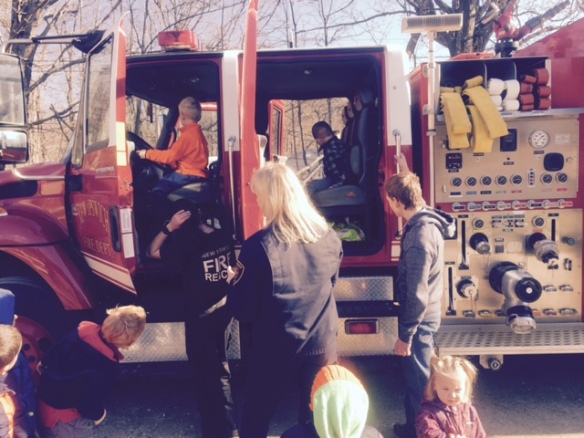
Perhaps what the two-year-old was trying to tell me was that, no matter how amazingly nice firemen and fire-women may be, something scary is involved in the subject.
For that matter, something scary is involved in the subject of fire, and even in the subject of winter. Both freezing and burning are scary.
Children are not as stupid as some seem to believe. (For that matter, neither are adults.) It is futile to gloss over reality with an insipid belief we can be spared a very real thing: Old Man Winter is coming, and will turn turf into tundra, and unless you befriend the dangerous realities of fuel and fire, you will die.
Some seem to believe children should be buffered in over-heated classrooms, with nature only seen on video screens, and spared knowing of the bitter winds that bluster and buffet outside. It likely a heresy for me to say this, but I think such mollycoddling harms, for the results of my highly scientific study suggests children are happier, healthier, and smarter when allowed to learn what their northern, Neanderthal genes already yearn to learn about, which is not the subjects of grammar, “social studies”, and algebra, but rather the subjects of shelter, fuel, and fire.
The sun is low at noon, and by four o’clock
The west is aflame: the sun is a fire
In the boughs of pines that bitter winds rock,
And their trunks send long shadows across mire
Turned to stone tundra. It’s north we’re heading.
The farm pond skims with ice too thin to tread;
There is no skating, no snow for sledding;
But the west grows dark with approaching dread
And the children aren’t fools. They want a fire.
I have solar lights that cast blue firefly
Dimness, but they want orange to inspire
Dancing and warm mirth. Should I not try
To teach fire is something other than danger?
Winter’s too cold when fire’s a stranger.




































































